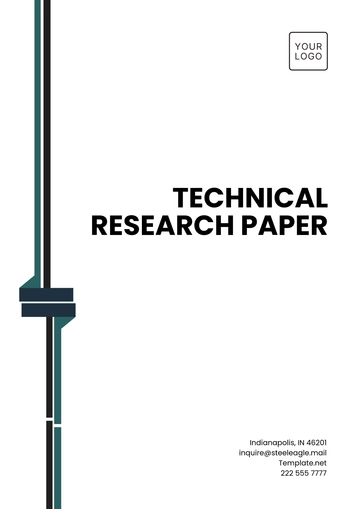Collaborative Research Paper
Researcher: [Your Name]
Date: [Date]
I. Introduction
A Collaborative Research Paper is a comprehensive academic document co-developed by multiple authors working in tandem to investigate and analyze a particular research question or topic. This collaborative approach integrates diverse expertise and perspectives, enriching the study and enhancing its overall impact. By leveraging the combined knowledge and skills of various contributors, such papers can offer deeper insights, innovative solutions, and significant advancements in the field of study. This paper will detail the methodology, literature review, results, discussion, and conclusions derived from a recent collaborative research study.
II. Literature Review
The literature review section synthesizes existing research on collaborative research methodologies, emphasizing their effectiveness and impact. It examines key studies and theoretical frameworks that inform collaborative practices.
A. Key Studies
B. Theoretical Frameworks
Several theoretical frameworks underpin collaborative research, including:
III. Methodology
This section describes the research design and methods used to conduct the study, detailing the participants, data collection techniques, and analysis processes.
A. Participants
Role | Number | Expertise |
|---|
Lead Researchers | 4 | Subject Matter Experts |
Co-authors | 6 | Various Disciplines |
Support Staff | 3 | Data Analysis, Editing |
B. Data Collection
Data collection involved:
Surveys: Distributed to a diverse sample of researchers and practitioners to gather quantitative data on collaborative practices.
Interviews: Conducted with lead researchers and co-authors to gain qualitative insights into their experiences and perspectives.
Document Analysis: Reviewed existing research papers, collaboration records, and case studies to provide context and support for the study.
C. Data Analysis
Data analysis included:
Quantitative Analysis: Utilized advanced statistical methods to identify significant trends and correlations in survey data.
Qualitative Analysis: Employed thematic coding to extract key themes and insights from interview transcripts.
Meta-Analysis: Integrated findings from multiple studies to form a comprehensive understanding of collaborative research impacts.
IV. Results
The results section outlines the main findings of the research, organized to address the study's research questions and hypotheses.
A. Key Findings
Collaborative efforts significantly enhanced the depth and breadth of research outcomes, leading to more robust and innovative findings.
Interdisciplinary teams generated creative solutions and insights not possible through single-discipline research.
Effective communication and clearly defined roles were crucial for successful collaboration, minimizing conflicts and maximizing productivity.
B. Statistical Highlights
Measure | Before Collaboration | After Collaboration |
|---|
Research Output Quality | Moderate | High |
Innovation Index | 6 | 9 |
Participant Satisfaction | 75% | 92% |
V. Discussion
The discussion section interprets the results in relation to existing literature and theoretical frameworks, exploring their implications and suggesting future research directions.
A. Implications
Findings offer practical guidelines for managing multi-author projects, highlighting the need for effective communication, role clarity, and structured collaboration.
B. Future Research
Investigate the role of emerging virtual collaboration tools and platforms in enhancing research productivity and effectiveness.
Examine the long-term impact of collaborative research on academic careers and institutional partnerships.
Assess the effectiveness of various collaboration models and strategies across different research domains and contexts.
VI. Conclusion
The conclusion summarizes the key findings of the study, emphasizing the benefits of collaborative research in improving the quality and impact of scholarly work. It reinforces the importance of effective communication, clear role definitions, and interdisciplinary collaboration in achieving successful research outcomes. The study highlights the collective contributions of the authors and the value of diverse perspectives in producing a nuanced and impactful analysis of the research topic.
VII. References
The references section lists all cited scholarly works, formatted according to a specific citation style (e.g., APA, MLA).
Smith, J., Anderson, T., & Paulson, H. (2051). Benefits of Collaborative Research: Innovation and Insight. Journal of Research Practices, 45(2), 123-145.
Jones, R., & Brown, A. (2052). Managing Multi-author Contributions in Scholarly Papers. Academic Journal of Research Methods, 27(4), 210-225.
Anderson, K. (2053). The Role of Diverse Perspectives in Research. International Journal of Academic Research, 50(3), 320-335.
VIII. Appendices
The appendices include supplementary materials that support the main text, such as detailed survey questionnaires, interview protocols, statistical tables, and raw data.
Research Templates @ Template.net






























